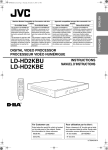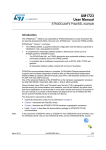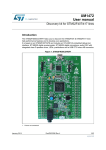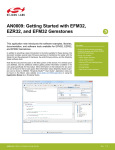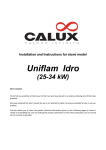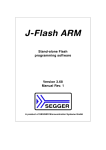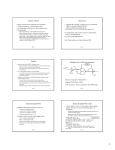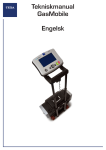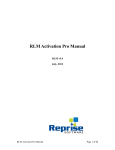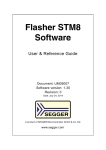Download Documentation
Transcript
emLib Library collection User & Reference Guide Document: UM12001 Software version: 1.0 Revision: 0 Date: July 17, 2013 A product of SEGGER Microcontroller GmbH & Co. KG www.segger.com 2 Disclaimer Specifications written in this document are believed to be accurate, but are not guaranteed to be entirely free of error. The information in this manual is subject to change for functional or performance improvements without notice. Please make sure your manual is the latest edition. While the information herein is assumed to be accurate, SEGGER Microcontroller GmbH & Co. KG (SEGGER) assumes no responsibility for any errors or omissions. SEGGER makes and you receive no warranties or conditions, express, implied, statutory or in any communication with you. SEGGER specifically disclaims any implied warranty of merchantability or fitness for a particular purpose. Copyright notice You may not extract portions of this manual or modify the PDF file in any way without the prior written permission of SEGGER. The software described in this document is furnished under a license and may only be used or copied in accordance with the terms of such a license. © 2013 SEGGER Microcontroller GmbH & Co. KG, Hilden / Germany Trademarks Names mentioned in this manual may be trademarks of their respective companies. Brand and product names are trademarks or registered trademarks of their respective holders. Contact address SEGGER Microcontroller GmbH & Co. KG In den Weiden 11 D-40721 Hilden Germany Tel.+49 2103-2878-0 Fax.+49 2103-2878-28 E-mail: [email protected] Internet: http://www.segger.com UM12001 User & Reference Guide for emLib © 2013 SEGGER Microcontroller GmbH & Co. KG 3 Manual versions This manual describes the current software version. If any error occurs, inform us and we will try to assist you as soon as possible. Contact us for further information on topics or routines not yet specified. Print date: July 17, 2013 Software Revision Date By 1.00 0 130321 JL UM12001 User & Reference Guide for emLib Description Initial release © 2013 SEGGER Microcontroller GmbH & Co. KG 4 UM12001 User & Reference Guide for emLib © 2013 SEGGER Microcontroller GmbH & Co. KG 5 About this document Assumptions This document assumes that you already have a solid knowledge of the following: • • • • The software tools used for building your application (assembler, linker, C compiler) The C programming language The target processor DOS command line If you feel that your knowledge of C is not sufficient, we recommend The C Programming Language by Kernighan and Richie (ISBN 0-13-1103628), which describes the standard in C-programming and, in newer editions, also covers the ANSI C standard. How to use this manual This manual explains all the functions and macros that the product offers. It assumes you have a working knowledge of the C language. Knowledge of assembly programming is not required. Typographic conventions for syntax This manual uses the following typographic conventions: Style Used for Body Body text. Keyword Text that you enter at the command-prompt or that appears on the display (that is system functions, file- or pathnames). Parameter Parameters in API functions. Sample Sample code in program examples. Sample comment Comments in programm examples. Reference Reference to chapters, sections, tables and figures or other documents. GUIElement Buttons, dialog boxes, menu names, menu commands. Emphasis Very important sections. Table 1.1: Typographic conventions UM12001 User & Reference Guide for emLib © 2013 SEGGER Microcontroller GmbH & Co. KG 6 SEGGER Microcontroller GmbH & Co. KG develops and distributes software development tools and ANSI C software components (middleware) for embedded systems in several industries such as telecom, medical technology, consumer electronics, automotive industry and industrial automation. SEGGER’s intention is to cut software development time for embedded applications by offering compact flexible and easy to use middleware, allowing developers to concentrate on their application. Our most popular products are emWin, a universal graphic software package for embedded applications, and embOS, a small yet efficient real-time kernel. emWin, written entirely in ANSI C, can easily be used on any CPU and most any display. It is complemented by the available PC tools: Bitmap Converter, Font Converter, Simulator and Viewer. embOS supports most 8/16/32-bit CPUs. Its small memory footprint makes it suitable for single-chip applications. Apart from its main focus on software tools, SEGGER develops and produces programming tools for flash micro controllers, as well as J-Link, a JTAG emulator to assist in development, debugging and production, which has rapidly become the industry standard for debug access to ARM cores. Corporate Office: http://www.segger.com EMBEDDED SOFTWARE (Middleware) emWin Graphics software and GUI emWin is designed to provide an efficient, processor- and display controller-independent graphical user interface (GUI) for any application that operates with a graphical display. embOS Real Time Operating System embOS is an RTOS designed to offer the benefits of a complete multitasking system for hard real time applications with minimal resources. embOS/IP TCP/IP stack embOS/IP a high-performance TCP/IP stack that has been optimized for speed, versatility and a small memory footprint. United States Office: http://www.segger-us.com SEGGER TOOLS Flasher Flash programmer Flash Programming tool primarily for micro controllers. J-Link JTAG emulator for ARM cores USB driven JTAG interface for ARM cores. J-Trace JTAG emulator with trace USB driven JTAG interface for ARM cores with Trace memory. supporting the ARM ETM (Embedded Trace Macrocell). J-Link / J-Trace Related Software Add-on software to be used with SEGGER’s industry standard JTAG emulator, this includes flash programming software and flash breakpoints. emFile File system emFile is an embedded file system with FAT12, FAT16 and FAT32 support. Various Device drivers, e.g. for NAND and NOR flashes, SD/MMC and CompactFlash cards, are available. USB-Stack USB device/host stack A USB stack designed to work on any embedded system with a USB controller. Bulk communication and most standard device classes are supported. UM12001 User & Reference Guide for © 2013 SEGGER Microcontroller GmbH & Co. KG 7 Table of Contents 1 Introduction to emLib .......................................................................................................9 1.1 1.2 1.3 1.3.1 What is emLib ......................................................................................... 10 Features................................................................................................. 10 Available modules.................................................................................... 10 Cryptographic modules............................................................................. 10 2 AES................................................................................................................................11 2.1 2.2 2.3 2.4 2.5 2.5.1 2.5.2 2.5.3 2.6 2.6.1 What is AES? .......................................................................................... 12 Using emLib AES ..................................................................................... 13 AES API functions .................................................................................... 14 Example codes ........................................................................................ 26 Sample applications ................................................................................. 30 AESCrypt................................................................................................ 31 AESSpeedtest ......................................................................................... 32 AESValidate ............................................................................................ 33 Performance and memory footprint ............................................................ 34 Performance test ..................................................................................... 34 3 DES................................................................................................................................35 3.1 3.2 3.3 3.4 3.5 3.5.1 3.5.2 3.6 3.6.1 What is DES? .......................................................................................... 36 Usind emLib DES ..................................................................................... 37 DES API functions.................................................................................... 38 Example codes ........................................................................................ 45 Sample applications ................................................................................. 47 DESSpeedtest ......................................................................................... 48 DESValidate ............................................................................................ 49 Performance and memory footprint ............................................................ 50 Performance test ..................................................................................... 50 UM12001 User & Reference Guide for emLib © 2013 SEGGER Microcontroller GmbH & Co. KG 8 UM12001 User & Reference Guide for emLib © 2013 SEGGER Microcontroller GmbH & Co. KG 9 Chapter 1 Introduction to emLib This chapter provides an introduction to emLib. It explains the basic concept behind emLib and its modules. UM12001 User & Reference Guide for emLib © 2013 SEGGER Microcontroller GmbH & Co. KG 10 CHAPTER 1 1.1 Introduction to emLib What is emLib emLib is a collection of software modules for different purposes. It currently includes AES and DES encryption. Modules for CRC, compression and aysmmetric encryption/ decryption are planned. The software is designed for portability to any device. The modules can be used in PC applications, as well as on embedded target devices. emLib is optimized for speed performance and a small memory footprint. The sources are completely written in ANSI-C and MISRA-C 2004 compliant. Validation code for the APIs using standard test patterns is included. 1.2 Features emLib is written in ANSI-C and can be used on virtually any CPU. Some features of emLib: • • • 1.3 Easy to integrate by using a simple API. Same modules and same API can be used in PC programs as well as on embedded targets. Sample applications for tests and validation of the modules included. Available modules 1.3.1 Cryptographic modules AES module Implemention of the AES 128 bit and 256 bit algorithm including chained block processing for en-/decryption of more than 16 Byte of data. DES module Implementation of the DES (56 bit) algorithm, also including CBC for processing more than 8 Byte of data. The DES functions can be called multiple times to achieve a higher security (TDES, tripel-DES). UM12001 User & Reference Guide for emLib © 2013 SEGGER Microcontroller GmbH & Co. KG 11 Chapter 2 AES The emLib AES module allows encryption and decryption of data using AES, the Advanced Encryption Standard as standardized by NIST in 2001. This chapter describes the AES API functions and shows their usage based on example codes. UM12001 User & Reference Guide for emLib © 2013 SEGGER Microcontroller GmbH & Co. KG 12 2.1 CHAPTER 2 AES What is AES? The Advanced Encryption Standard, short AES, is a symmetric-key algorithm used for encryption an decryption of data. It was established by the U.S. National Institute of Standards and Technology (NIST) and is the standard for encrypting electronic data since 2001. AES supersedes the Data Encryption Standard (DES). AES is a substitution-permutation network block cipher using a fixed block size of 128 bits and a key size of 128, 192 or 256 bits. The data block is stored in a 4-row matrix with a cell size of 8 bits. Based on the key length, these blocks are transformed using parts of the key in a number of rounds. AES 128 uses 10 rounds, AES 256 14. Therefore encryption with AES 256 is ~40% slower than AES 128. In each round a round key is derived from the original key. Afterwards each byte is non-linear substituted according to a lookup table, the rows of the data matrix are shifted cyclically and mixed. emLib AES uses a key of 128 or 256 bits to encrypt a block of 16 bytes of data at a time. To optimize the performance of the algorithms the generation of the round keys can be done before the actual encryption or decryption and used more than one time. For the substitution and mixing steps, emLib can be built with pre-calculated lookup tables, to increase the speed performance. emLib can also be built without these tables, to save memory. AES can also be used in cipher block chaining (CBC) mode to process a multiple of 16 Bytes. In CBC mode every chunk of 16 Bytes is XOR linked with the result of the previous encryption (the cipher text), before being encrypted. To decrypt one block, all previous blocks have to be known. For the encryption of the first block an initialization vector which will be linked with the block, can be used to make sure the first block cannot be brute-force decrypted by comparing it to common first data blocks. UM12001 User & Reference Guide for emLib © 2013 SEGGER Microcontroller GmbH & Co. KG 13 2.2 Using emLib AES The emLib AES module has a simple yet powerful API. It can be easily integrated into an existing application. The code is completely written in ANSI-C and MISRA-C compliant. All functionality can be verified with standard test patterns using the Validation API functions. The functions for generating the tables used for higher optimization levels are also included for full transparency. The module can be built with configurable optimizations to fit any requirement of high speed or low memory usage. To simply encrypt or decrypt data the application would only need to call one function. If more than one block needs to be processed with the same key, a context containing the round keys calculated from the key can be prepared and directly used by the encryption and decryption functions. For more than one call of these functions this method results in a slightly higher processing speed. The following section lists and describes the available API functions of the emLib AES module. UM12001 User & Reference Guide for emLib © 2013 SEGGER Microcontroller GmbH & Co. KG 14 2.3 CHAPTER 2 AES AES API functions The table below lists the available API functions. Function AES128_CBC_Decrypt() AES128_CBC_Encrypt() AES128_Decrypt() AES128_Encrypt() AES128_Prepare() AES256_CBC_Decrypt() AES256_CBC_Encrypt() AES256_Decrypt() AES256_Encrypt() AES256_Prepare() AES_Validate() Description Decrypts data with AES 128 Bit using CBC. Encrypts data with AES 128 Bit using CBC. Decrypts 16 Bytes with AES 128 Bit. Encrypts 16 Bytes with AES 128 Bit. Prepares the context for de-/encryption. Decrypts data with AES 256 Bit using CBC. Encrypts data with AES 256 Bit using CBC. Decrypts 16 Bytes with AES 256 Bit. Encrypts 16 Bytes with AES 256 Bit. Prepares the context for de-/encryption. Test function for validation of AES. Table 2.1: AES API function overview UM12001 User & Reference Guide for emLib © 2013 SEGGER Microcontroller GmbH & Co. KG 15 2.3.1 AES128_Prepare() Description Prepares the context depending on the key used for AES 128bit de-/encryption. Prototype void AES128_Prepare (AES_CONTEXT * pContext, const U8 * pKey); Parameter pContext pKey Description Pointer to the context for de-/encryption. Pointer to the buffer which holds the encryption key (128bit). Table 2.2: AES128_Prepare() parameter list Additional information The key has to be 128 bit (16 Byte) long. Example See AES 128bit en-/decryption of 16 Bytes on page 26 UM12001 User & Reference Guide for emLib © 2013 SEGGER Microcontroller GmbH & Co. KG 16 CHAPTER 2 2.3.2 AES AES128_Encrypt() Description Encrypts a block of 16 Bytes (128 bit) using a context prepared with a 128 bit key. Prototype void AES128_Encrypt (AES_CONTEXT * pContext, U8 * pDest, const U8 * pSrc); Parameter pContext pDest pSrc Description Pointer to the previously prepared context. Pointer to the buffer which will hold the encrypted data. Pointer to the buffer which holds the unencrypted data. Table 2.3: AES128_Encrypt() parameter list Additional information The data which will be encrypted has to be 16 Bytes. For more than 16 Bytes see AES128_CBC_Encrypt() on page 21. Example See AES 128bit en-/decryption of 16 Bytes on page 26 UM12001 User & Reference Guide for emLib © 2013 SEGGER Microcontroller GmbH & Co. KG 17 2.3.3 AES128_Decrypt() Description Decrypts a block of 16 Bytes (128 bit) using a context prepared with a 128 bit key. Prototype void AES128_Decrypt (AES_CONTEXT * pContext, U8 * pDest, const U8 * pSrc); Parameter pContext pDest pSrc Description Pointer to the previously prepared context. Pointer to the buffer which will hold the decrypted data. Pointer to the buffer which holds the encrypted data. Table 2.4: AES128_Decrypt() parameter list Additional information The key has to be the same as the one used for encryption. The data which will be decrypted has to be 16 Bytes. For more than 16 Bytes see AES128_CBC_Decrypt() on page 22. Example See AES 128bit en-/decryption of 16 Bytes on page 26 UM12001 User & Reference Guide for emLib © 2013 SEGGER Microcontroller GmbH & Co. KG 18 CHAPTER 2 2.3.4 AES AES256_Prepare() Description Prepares the context depending on the key used for AES 256bit de-/encryption. Prototype void AES256_Prepare (AES_CONTEXT * pContext, const U8 * pKey); Parameter pContext pKey Description Pointer to the context for de-/encryption. Pointer to the buffer which holds the encryption key (256bit). Table 2.5: AES256_Prepare() parameter list Additional information The key has to be 256 bit (32 Byte) long. Example See AES 256bit en-/decryption of 16 Bytes on page 28 UM12001 User & Reference Guide for emLib © 2013 SEGGER Microcontroller GmbH & Co. KG 19 2.3.5 AES256_Encrypt() Description Encrypts a block of 16 Bytes (128 bit) using a context prepared with the 256 bit key. Prototype void AES128_Encrypt (AES_CONTEXT * pContext, U8 * pDest, const U8 * pSrc); Parameter pContext pDest pSrc Description Pointer to the previously prepared context. Pointer to the buffer which will hold the encrypted data. Pointer to the buffer which holds the unencrypted data. Table 2.6: AES256_Encrypt() parameter list Additional information The data which will be encrypted has to be 16 Bytes. For more than 16 Bytes see AES256_CBC_Encrypt() on page 23. Example See AES 256bit en-/decryption of 16 Bytes on page 28 UM12001 User & Reference Guide for emLib © 2013 SEGGER Microcontroller GmbH & Co. KG 20 CHAPTER 2 2.3.6 AES AES256_Decrypt() Description Decrypts a block of 16 Bytes (128 bit) using a context prepared with the 256 bit key. Prototype void AES128_Decrypt (AES_CONTEXT * pContext, U8 * pDest, const U8 * pSrc); Parameter pContext pDest pSrc Description Pointer to the previously prepared context. Pointer to the buffer which will hold the decrypted data. Pointer to the buffer which holds the encrypted data. Table 2.7: AES256_Decrypt() parameter list Additional information The key has to be the same as the one used for encryption. The data which will be decrypted has to be 16 Bytes. For more than 16 Bytes see AES256_CBC_Decrypt() on page 24. Example See AES 256bit en-/decryption of 16 Bytes on page 28 UM12001 User & Reference Guide for emLib © 2013 SEGGER Microcontroller GmbH & Co. KG 21 2.3.7 AES128_CBC_Encrypt() Description Encrypts data using cypher block chaining and a 128 bit key. Prototype void AES128_CBC_Encrypt (AES_CONTEXT * pContext, U8 * pDest, const U8 * pSrc, int NumBytes, const U8 * pIV); Parameter pContext pDest pSrc NumBytes pIV Description Pointer to the previously prepared context. Pointer to the buffer which will hold the encrypted data. Pointer to the buffer which holds the data. Number of Bytes which have to be encrypted Pointer to the buffer which holds the initialization verctor. Table 2.8: AES128_CBC_Encrypt() parameter list Additional information The length of the data has to be a multiple of 16 bytes. If pIV is NULL the first block will not be linked. pDest and pSrc may be the same, if the plain data is not needed after encryption. Example See AES 128bit en-/decryption of 32 Bytes using CBC on page 27 UM12001 User & Reference Guide for emLib © 2013 SEGGER Microcontroller GmbH & Co. KG 22 CHAPTER 2 2.3.8 AES AES128_CBC_Decrypt() Description Decrypts data using cypher block chaining and a 128 bit key. Prototype void AES128_CBC_Decrypt (AES_CONTEXT * pContext, U8 * pDest, const U8 * pSrc, int NumBytes, const U8 * pIV); Parameter pContext pDest pSrc NumBytes pIV Description Pointer to the previously prepared context. Pointer to the buffer which will hold the decrypted data. Pointer to the buffer which holds the encrypted data. Number of Bytes which have to be decrypted Pointer to the buffer which holds the initialization verctor. Table 2.9: AES128_CBC_Decrypt() parameter list Additional information The key and the initialization vector have to be the same as used for encryption. The length of the data has to be a multiple of 16 bytes. If pIV is NULL the first block will not be linked. pDest and pSrc must be different. Example See AES 128bit en-/decryption of 32 Bytes using CBC on page 27 UM12001 User & Reference Guide for emLib © 2013 SEGGER Microcontroller GmbH & Co. KG 23 2.3.9 AES256_CBC_Encrypt() Description Encrypts data using cypher block chaining and a 256 bit key. Prototype void AES128_CBC_Encrypt (AES_CONTEXT * pContext, U8 * pDest, const U8 * pSrc, int NumBytes, const U8 * pIV); Parameter pContext pDest pSrc NumBytes pIV Description Pointer to the previously prepared context. Pointer to the buffer which will hold the encrypted data. Pointer to the buffer which holds the data. Number of Bytes which have to be encrypted Pointer to the buffer which holds the initialization vector. Table 2.10: AES256_CBC_Encrypt() parameter list Additional information The length of the data has to be a multiple of 16 bytes. If pIV is NULL the first block will not be linked. pDest and pSrc may be the same, if the plain data is not needed after encryption. Example See AES 256bit en-/decryption of 32 Bytes using CBC on page 29 UM12001 User & Reference Guide for emLib © 2013 SEGGER Microcontroller GmbH & Co. KG 24 CHAPTER 2 AES 2.3.10 AES256_CBC_Decrypt() Description Decrypts data using cypher block chaining and a 256 bit key. Prototype void AES128_CBC_Decrypt (AES_CONTEXT * pContext, U8 * pDest, const U8 * pSrc, int NumBytes, const U8 * pIV); Parameter pContext pDest pSrc NumBytes pIV Description Pointer to the previously prepared context. Pointer to the buffer which will hold the decrypted data. Pointer to the buffer which holds the encrypted data. Number of Bytes which have to be decrypted Pointer to the buffer which holds the initialization vector. Table 2.11: AES256_CBC_Decrypt() parameter list Additional information The key and the initialization vector have to be the same as used for encryption. The length of the data has to be a multiple of 16 bytes. If pIV is NULL the first block will not be linked. pDest and pSrc must be different. Example See AES 256bit en-/decryption of 32 Bytes using CBC on page 29 UM12001 User & Reference Guide for emLib © 2013 SEGGER Microcontroller GmbH & Co. KG 25 2.3.11 AES_Validate() Description This function can be used to test the AES implementation. It en- and decrypts specified data and checks for valid output. Prototype int AES_Validate (void); Return values 0: O.K. No error. <0: Error. The implementation is not working correctly. Additional information The data for the validation is taken from RFC 3062 (http://www.rfc-editor.org/rfc/ rfc3602.txt Chapter 4). UM12001 User & Reference Guide for emLib © 2013 SEGGER Microcontroller GmbH & Co. KG 26 CHAPTER 2 2.4 AES Example codes 2.4.1 AES 128bit en-/decryption of 16 Bytes This sample shows how to encrypt and afterwards decrypt 16 bytes of data with AES and a 128 bit key. #include “AES.h” const U8 _aKey[16] = {0x00, 0x01, 0x02, 0x03, 0x04, 0x05, 0x06, 0x07, 0x08, 0x09, 0x0a, 0x0b, 0x0c, 0x0d, 0x0e, 0x0f}; const U8 _aPlaintext[16] = {0x00, 0x11, 0x22, 0x33, 0x44, 0x55, 0x66, 0x77, 0x88, 0x99, 0xaa, 0xbb, 0xcc, 0xdd, 0xee, 0xff}; int main() { U8 aEncrypted[16]; U8 aDecrypted[16]; AES_CONTEXT Context; // // Prepares the AES Context with _aKey // AES128_Prepare(&Context, &_aKey[0]); // // Encrypts the data from _aPlaintext and stores it in aEncrypted // AES128_Encrypt(&Context, &aEncrypted[0], &_aPlaintext[0]); // // Decrypts the data from aEncrypted and stores it in aDecrypted // AES128_Decrypt(&Context, &aDecrypted[0], &aEncrypted[0]); // // Check if aDecrypted is the same as _aPlaintext // if (memcmp(&aDecrypted[0], _aPlaintext, 16)) { return -1; } return 0; } UM12001 User & Reference Guide for emLib © 2013 SEGGER Microcontroller GmbH & Co. KG 27 2.4.2 AES 128bit en-/decryption of 32 Bytes using CBC This sample shows how to encrypt and afterwards decrypt 32 bytes of data with AES and a 128 bit key using Cipher Block Chaining. #include “AES.h” const U8 _aKey[16] = { 0xc2, 0x86, 0x69, 0x6d, 0x88, 0x7c, 0x9a, 0xa0, 0x61, 0x1b, 0xbb, 0x3e, 0x20, 0x25, 0xa4, 0x5a}; static const U8 _aIV[16] = { 0x56, 0x2e, 0x17, 0x99, 0x6d, 0x09, 0x3d, 0x28, 0xdd, 0xb3, 0xba, 0x69, 0x5a, 0x2e, 0x6f, 0x58}; static const U8 _aPlaintext[32] = { 0x00, 0x08, 0x10, 0x18, 0x01, 0x09, 0x11, 0x19, 0x02, 0x0a, 0x12, 0x1a, 0x03, 0x0b, 0x13, 0x1b, 0x04, 0x0c, 0x14, 0x1c, 0x05, 0x0d, 0x15, 0x1d, 0x06, 0x0e, 0x16, 0x1e, 0x07, 0x0f, 0x17, 0x1f}; 0x96, 0x86, 0x86, 0x82, 0xcd, 0x30, 0x60, 0x66, 0x94, 0x28, 0x2d, 0xbe, 0xc2, 0xb5, 0x25, 0xa6, 0xcc, 0xe1, 0x3c, 0xd6, 0xcf, 0xdc, 0xff, 0x1a, 0x8a, 0x0a, 0xf9, 0xb1}; static const U8 _aCiphertext[32] = { 0xd2, 0x3a, 0x75, 0x1b, int main() { U8 aEnc[32]; U8 aPlain[32]; AES_CONTEXT Context; // // Prepare the context with _aKey // AES128_Prepare(&Context, &_aKey[0]); // // Encrypt the data of _aPlaintext // and compare it with the desired result. // AES128_CBC_Encrypt(&Context, &aEnc[0], &_aPlaintext[0], 32, &_aIV[0]); if (memcmp(&aEnc[0], &_aCiphertext[0], 32)) { return -1; } // // Decrypt the data of aEnc // and compare it with the previously used _aPlaintext // AES128_CBC_Decrypt(&Context, &aPlain[0], &aEnc[0], 32, &_aIV[0]); if (memcmp(&aPlain[0], &_aPlaintext[0], 32)) { return -1; } return 0; // AES 128 CBC works fine. } UM12001 User & Reference Guide for emLib © 2013 SEGGER Microcontroller GmbH & Co. KG 28 CHAPTER 2 2.4.3 AES AES 256bit en-/decryption of 16 Bytes This sample shows how to encrypt and afterwards decrypt 16 bytes of data with AES and a 256 bit key. #include “AES.h” const U8 _aKey[32] = {0x00, 0x08, 0x10, 0x18, 0x01, 0x09, 0x11, 0x19, 0x02, 0x0a, 0x12, 0x1a, 0x03, 0x0b, 0x13, 0x1b, 0x04, 0x0c, 0x14, 0x1c, 0x05, 0x0d, 0x15, 0x1d, 0x06, 0x0e, 0x16, 0x1e, 0x07, 0x0f, 0x17, 0x1f}; const U8 _aPlaintext[16] = {0x00, 0x11, 0x22, 0x33, 0x44, 0x55, 0x66, 0x77, 0x88, 0x99, 0xaa, 0xbb, 0xcc, 0xdd, 0xee, 0xff}; int main() { U8 aEncrypted[16]; U8 aDecrypted[16]; AES_CONTEXT Context; // // Prepares the AES Context with _aKey // AES256_Prepare(&Context, &_aKey[0]); // // Encrypts the data from _aPlaintext and stores it in aEncrypted // AES256_Encrypt(&Context, &aEncrypted[0], &_aPlaintext[0]); // // Decrypts the data from aEncrypted and stores it in aDecrypted // AES256_Decrypt(&Context, &aDecrypted[0], &aEncrypted[0]); // // Check if aDecrypted is the same as _aPlaintext // if (memcmp(&aDecrypted[0], _aPlaintext, 16)) { return -1; } return 0; } UM12001 User & Reference Guide for emLib © 2013 SEGGER Microcontroller GmbH & Co. KG 29 2.4.4 AES 256bit en-/decryption of 32 Bytes using CBC This sample shows how to encrypt and afterwards decrypt 32 bytes of data with AES and a 256 bit key using Cipher Block Chaining. #include “AES.h” const U8 _aKey[32] = { 0x00, 0x08, 0x10, 0x18, 0x01, 0x09, 0x11, 0x19, 0x02, 0x0a, 0x12, 0x1a, 0x03, 0x0b, 0x13, 0x1b, 0x04, 0x0c, 0x14, 0x1c, 0x05, 0x0d, 0x15, 0x1d, 0x06, 0x0e, 0x16, 0x1e, 0x07, 0x0f, 0x17, 0x1f}; static const U8 _aIV[16] = { 0x56, 0x2e, 0x17, 0x99, 0x6d, 0x09, 0x3d, 0x28, 0xdd, 0xb3, 0xba, 0x69, 0x5a, 0x2e, 0x6f, 0x58}; static const U8 _aPlaintext[32] = { 0x00, 0x08, 0x10, 0x18, 0x01, 0x09, 0x11, 0x19, 0x02, 0x0a, 0x12, 0x1a, 0x03, 0x0b, 0x13, 0x1b, 0x04, 0x0c, 0x14, 0x1c, 0x05, 0x0d, 0x15, 0x1d, 0x06, 0x0e, 0x16, 0x1e, 0x07, 0x0f, 0x17, 0x1f}; int main() { U8 aEnc[32]; U8 aPlain[32]; AES_CONTEXT Context; // // Prepare the context with _aKey // AES256_Prepare(&Context, &_aKey[0]); // // Encrypt the data of _aPlaintext // AES256_CBC_Encrypt(&Context, &aEnc[0], &_aPlaintext[0], 32, &_aIV[0]); // // Decrypt the data of aEnc // and compare it with the previously used _aPlaintext // AES256_CBC_Decrypt(&Context, &aPlain[0], &aEnc[0], 32, &_aIV[0]); if (memcmp(&aPlain[0], &_aPlaintext[0], 32)) { return -1; } return 0; // AES 256 CBC works fine. } UM12001 User & Reference Guide for emLib © 2013 SEGGER Microcontroller GmbH & Co. KG 30 2.5 CHAPTER 2 AES Sample applications emLib includes some sample applications to show the modules functionality and provide an easy to use starting point for your application. The application’s source code is included within the module. The following applications are included in emLib AES: Application name Target platform AESCrypt.exe Windows AESSpeedtest.exe Windows AESValidate.exe Windows Description Commandline tool to en-/decrypt a file using AES 256. Console application testing the speed of emLib AES. Console application validating emLib AES with standard test patterns. Table 2.12: Sample Applications UM12001 User & Reference Guide for emLib © 2013 SEGGER Microcontroller GmbH & Co. KG 31 2.5.1 AESCrypt AESCrypt is a windows application, encrypting and decrypting a file with the given keyword. The tool can be used to easily keep files secured. Usage “AESCrypt” <sourcefile> [<password>] [<option>] Parameter <sourcefile> <password> <option> Description Path to the file, which has to be en-/decrypted. Password used for en-/decryption. (optional) “-en”: Force encryption of the source file. “-de”: Force decryption of the source file. If no option is given, operation depends on source file extension. Table 2.13: AESCrypt parameter list Additional information The password can contain any character and does not have a fixed required length. The output file after encryption will have the extension “.enc”. If present, the original file will be renamed to <Filename>.orig, when decrypting a file with the same name. UM12001 User & Reference Guide for emLib © 2013 SEGGER Microcontroller GmbH & Co. KG 32 CHAPTER 2 2.5.2 AES AESSpeedtest AESSpeedtest is a windows application, testing the performance of the emLib AES algorithms. UM12001 User & Reference Guide for emLib © 2013 SEGGER Microcontroller GmbH & Co. KG 33 2.5.3 AESValidate AESValidate is a Windows application used to test and validate the implementation of the AES algorithms. The application uses the Validation API and compares the results of encryption and decryption with the expected results. AESValidate will show an error message, if a validation test fails. UM12001 User & Reference Guide for emLib © 2013 SEGGER Microcontroller GmbH & Co. KG 34 CHAPTER 2 2.6 AES Performance and memory footprint emLib AES aims for portability and is designed to fit speed and size requirements for different targets. It includes configurable defines to switch between speed and size optimizations. The values can be changed in AES_Config.h. #define 0 1 0 1 2 OPTIMIZE_MIX_SUBST OPTIMIZE_MIX_COLUMNS Values Description (No opt.) (default) (default) Use a 32-bit table to perform "MixColumns" and "SubBytes" at the same time. (highest) Use tables for matrix multiplication. Table 2.14: Optimization defines 2.6.1 Performance test The following system has been used to measure the performance and memory footprint of the module with different optimization levels. Detail Target Tool chain Description: STM32F417 running at 168 MHz, internal flash used IAR EWARM V6.40E Table 2.15: Performance test configuration Results The following table shows the en- and decryption speed of emLib AES128: Compiler options Optimize high for speed Optimize high for size Module #defines Speed OPTIMIZE_MIX_SUBST OPTIMIZE_MIX_COLUMNS OPTIMIZE_MIX_SUBST OPTIMIZE_MIX_COLUMNS 1 ~1.3 MByte/sec 2 0 ~0.4 MByte/sec 0 ROM usage ~11.8 KBytes ~3.4 KBytes The performance depends on the MCU speed and the flash memory speed. Results may vary if a different setup is used. UM12001 User & Reference Guide for emLib © 2013 SEGGER Microcontroller GmbH & Co. KG 35 Chapter 3 DES The emLib DES module allows encryption and dycryption of data using DES, the Data Encryption Standard as published in 1976. This chapter describes the DES API functions and shows their usage based on example codes. In this chapter, you will find a description of the DES module API functions and samples for their implementation. UM12001 User & Reference Guide for emLib © 2013 SEGGER Microcontroller GmbH & Co. KG 36 3.1 CHAPTER 3 DES What is DES? The Data Encryption Standard, short DES, is a symmetric-key algorithm for en- and decryption of data. It was developed in the 1970’s and established as a standard for the United States by the National Bureau of Standards (NBS, now NIST). DES has been superseded by AES. DES is a block cypher, taking a fixed-length block of data (64 bits). The key used for processing consists of 64 bits, where only 56 are actually used for transformations and 8 bits are used for parity checks. DES performs an initial permitation of the data, 16 rounds of transformation, and a final permitation, the inverse of the initial permutation. In the transformations the data block is initially splitted in two 32 bit blocks where the first block is transformated with the round key using a Feistel cipher and XOR-linked with the second block. The first block and the resulting block are used for the next round. emLib DES uses a key of 64 bits to encrypt a block of 68 bits of data at a time. To optimize the performance of the algorithms the generation of the round keys can be done before the actual encryption or decryption and used more than one time. DES can also be used in cipher block chaining (CBC) mode to process more than 64 bits. In CBC mode every chunk of 64 bits is XOR linked with the result of the previous encryption (the cipher text), before being encrypted. To decrypt one block, all previous blocks have to be known. For the encryption of the first block an initialization vector which will be linked with the block, can be used to make sure the first block cannot be brute-force decrypted by comparing it to common first data blocks. UM12001 User & Reference Guide for emLib © 2013 SEGGER Microcontroller GmbH & Co. KG 37 3.2 Usind emLib DES The emLib DES module has a simple yet powerful API. It can be easily integrated into an existing application. The code is completely written in ANSI-C and MISRA-C compliant. All functionality can be verified with standard test patterns using the Validation API functions. The functions for generating the tables used for higher optimization levels are also included for full transparency. To simply encrypt or decrypt data the application would only need to call one function. If more than one block needs to be processed with the same key, a context containing the round keys calculated from the key can be prepared and directly used by the encryption and decryption functions. For more than one call of these functions this method results in a slightly higher processing speed. The following section lists and describes the available API functions of the emLib DES module. UM12001 User & Reference Guide for emLib © 2013 SEGGER Microcontroller GmbH & Co. KG 38 3.3 CHAPTER 3 DES DES API functions The table below lists the available API functions. Function DES_CBC_Encrypt() DES_CBC_Decrypt() DES_Decrypt() DES_Encrypt() DES_Prepare() DES_Validate() Description Encrypts data with DES using CBC. Decrypts data with DES using CBC. Decrypts 8 Bytes with DES. Encrypts 8 Bytes with DES. Prepares the context for de-/encryption. Test function for validation of DES. Table 3.1: DES API function overview UM12001 User & Reference Guide for emLib © 2013 SEGGER Microcontroller GmbH & Co. KG 39 3.3.1 DES_Prepare() Description Prepares the context depending on the 64bit key used for DES de-/encryption. Prototype void DES_Prepare(DES_CONTEXT * pContext, const U8 * pKey); Parameter pContext pKey Description Pointer to the context for de-/encryption. Pointer to the buffer which holds the encryption key (64bit). Table 3.2: DES_Prepare() parameter list Additional information The key has 1 parity bit per byte, so the effective key length is 56bit. A pointer to a 64bit key has to be provided to the function. Example See DES en-/decryption of 8 Bytes on page 45 UM12001 User & Reference Guide for emLib © 2013 SEGGER Microcontroller GmbH & Co. KG 40 CHAPTER 3 3.3.2 DES DES_Encrypt() Description Encrypts a block of 8 Bytes (64 bit) using a context prepared with the 64 bit key. Prototype void DES_Encrypt (DES_CONTEXT * pContext, U8 * pDest, const U8 * pSrc); Parameter pContext pDest pSrc Description Pointer to the prepared context for DES encryption. Pointer to the buffer for the encrypted data Pointer to the plain text data buffer which has to be encrypted. Table 3.3: DES_Encrypt() parameter list Additional information The data has to be 64bit. For more than 64 bit see DES_CBC_Encrypt() on page 42. Example See DES en-/decryption of 8 Bytes on page 45 UM12001 User & Reference Guide for emLib © 2013 SEGGER Microcontroller GmbH & Co. KG 41 3.3.3 DES_Decrypt() Description Decrypts a block of 8 Bytes (64 bit) using a context prepared with the 64 bit key. Prototype void DES_Decrypt (DES_CONTEXT * pContext, U8 * pDest, const U8 * pSrc); Parameter pContext pDest pSrc Description Pointer to the prepared DES conctext. Pointer to the buffer for the decrypted data. Pointer to the buffer with the encrypted data. Table 3.4: DES_Decrypt() parameter list Additional information The key has to be the same as the one used for encryption. The data which will be decrypted has to be 64bit long. For more than 64bit see DES_CBC_Decrypt() on page 43. Example See DES en-/decryption of 8 Bytes on page 45 UM12001 User & Reference Guide for emLib © 2013 SEGGER Microcontroller GmbH & Co. KG 42 CHAPTER 3 3.3.4 DES DES_CBC_Encrypt() Description Encrypts a block of data using DES with cypher blcok chaining. Prototype void DES_CBC_Encrypt (DES_CONTEXT * pContext, U8 * pDest, const U8 * pSrc, int NumBytes, const U8 * pIV); Parameter pContext pDest pSrc NumBytes pIV Description Pointer to the DES context. Pointer to the data buffer for the encrypted data. Pointer to the plain data buffer. Number of Bytes, which has to be encrypted. [optional] Initialization vector for the first block of data. Table 3.5: DES_CBC_Encrypt() parameter list Additional information The data has to be a multiple of 8 Byte. To prepare the context use DES_Prepare(). If pIV is NULL, an initialization vector of 0 is used. Example See DES en-/decryption of 16 Bytes using CBC on page 46 UM12001 User & Reference Guide for emLib © 2013 SEGGER Microcontroller GmbH & Co. KG 43 3.3.5 DES_CBC_Decrypt() Description Decrypts a data block using DES with cypher block chaining. Prototype void DES_CBC_Decrypt (DES_CONTEXT * pContext, U8 * pDest, const U8 * pSrc, int NumBytes, const U8 * pIV); Parameter pContext pDest pSrc NumBytes pIV Description Pointer to the DES context. Pointer to the buffer for the decrypted data. Pointer to the buffer with encrypted data. Number of Bytes which has to be decrypted. [optional] Initialization vector used for the first data block. Table 3.6: DES_CBC_Decrypt() parameter list Additional information The context has to be generated with the same key as for encryption. The initialization vector has to be the same as for encryption. If pIV is NULL an initialization vector of 0 is used. The data has to be a multiple of 8 Bytes. Example See DES en-/decryption of 16 Bytes using CBC on page 46 UM12001 User & Reference Guide for emLib © 2013 SEGGER Microcontroller GmbH & Co. KG 44 CHAPTER 3 3.3.6 DES DES_Validate() Description This function is used to test the DES implementation. It uses defined plain data and a defined key for encryption and checks if the encryption result is correct. The initialization vector is 0. Prototype int DES_Validate (void); Return values 0: O.K. No error. -1: Error. Encryption failed. The implementation is not working correctly. -2: Error. Decryption failed. The implementation is not working correctly. Additional information Validation set from NIST special publication 800-17. UM12001 User & Reference Guide for emLib © 2013 SEGGER Microcontroller GmbH & Co. KG 45 3.4 Example codes 3.4.1 DES en-/decryption of 8 Bytes #include <DES.h> int main(void) { DES_CONTEXT Context; const U8 aKey[8] = {0x01, 0x23, 0x45, 0x67, 0x89, 0xAB, 0xCD, 0xEF}; const U8 aPlain[8] = {0x01, 0x23, 0x45, 0x67, 0x89, 0xAB, 0xCD, 0xE7}; U8 aRefPlain[8]; U8 aCipher[8]; int r; // // Prepare the DES Context with aKey // DES_PrepareKey(&Context, &aKey[0]); // // Encrypt the data of aPlain // DES_Encrypt(&Context, &aCipher[0], &aPlain[0]); // // Decrypt the data of aCipher // DES_Decrypt(&Context, &aRefPlain[0], &aCipher[0]); r = memcmp(&aPlain[0], &aRefPlain[0], sizeof(aRefPlain)); if (r != 0) { return -2; } return r; // DES works fine. } UM12001 User & Reference Guide for emLib © 2013 SEGGER Microcontroller GmbH & Co. KG 46 CHAPTER 3 3.4.2 DES DES en-/decryption of 16 Bytes using CBC #include <DES.h> int main(void) { DES_CONTEXT Context; const U8 aKey[8] const U8 aPlain[16] = {0x01, 0x23, 0x45, 0x67, 0x89, 0xAB, 0xCD, 0xEF}; = {0x01, 0x23, 0x45, 0x67, 0x89, 0xAB, 0xCD, 0xE7, 0x01, 0x23, 0x45, 0x67, 0x89, 0xAB, 0xCD, 0xE7}; U8 aRefPlain[16]; U8 aCipher[16]; int r; // // Prepare the DES Context with aKey // DES_PrepareKey(&Context, &aKey[0]); // // Encrypt the data of aPlain // DES_CBC_Encrypt(&Context, &aCipher[0], &aPlain[0], sizeof(aPlain), NULL); // // Decrypt the data of aCipher // DES_CBC_Decrypt(&Context, &aRefPlain[0], &aCipher[0], sizeof(aCipher), NULL); r = memcmp(&aPlain[0], &aRefPlain[0], sizeof(aRefPlain)); if (r != 0) { return -2; } return r; // DES works fine. } UM12001 User & Reference Guide for emLib © 2013 SEGGER Microcontroller GmbH & Co. KG 47 3.5 Sample applications emLib includes some sample applications to show the modules functionality and provide an easy to use starting point for your application. The application’s source code is included within the module. The following applications are included in emLib DES: Application name Target platform DESSpeedtest.exe Windows DESValidate.exe Windows Description Console application testing the speed of emLib DES. Console application validating emLib DES with standard test patterns. Table 3.7: Sample Applications UM12001 User & Reference Guide for emLib © 2013 SEGGER Microcontroller GmbH & Co. KG 48 CHAPTER 3 3.5.1 DES DESSpeedtest DESSpeedtest is a windows application, testing the performance of the emLib DES algorithms. UM12001 User & Reference Guide for emLib © 2013 SEGGER Microcontroller GmbH & Co. KG 49 3.5.2 DESValidate DESValidate is a Windows application used to test and validate the implementation of the DES algorithms. The application uses the Validation API and compares the results of encryption and decryption with the expected results. DESValidate will show an error message, if a validation test fails. UM12001 User & Reference Guide for emLib © 2013 SEGGER Microcontroller GmbH & Co. KG 50 CHAPTER 3 3.6 DES Performance and memory footprint emLib DES aims for portability and is designed to fit speed and size requirements for different targets. 3.6.1 Performance test The following system has been used to measure the performance and memory footprint of the module with different optimization levels. Detail Target Tool chain Description: STM32F417 running at 168 MHz, internal flash used IAR EWARM V6.40E Table 3.8: Performance test configuration Results The following table shows the en- and decryption speed of emLib DES: Compiler options Optimize high for speed Optimize high for size Speed ~0.8 MByte/sec ~0.6 MByte/sec ROM usage ~3.2 KBytes ~3.0 KBytes The performance depends on the MCU speed and the flash memory speed. Results may vary if a different setup is used. UM12001 User & Reference Guide for emLib © 2013 SEGGER Microcontroller GmbH & Co. KG 51 Index A AES ...................................................12 C CBC ...................................................36 Ciphertext ..........................................12 D DES ...................................................36 F Feistel cipher .......................................36 I Initialization Vector ..............................12 S Syntax, conventions used ...................... 5 UM12001 User & Reference Guide for emLib © 2013 SEGGER Microcontroller GmbH & Co. KG 52 UM12001 User & Reference Guide for emLib Index © 2013 SEGGER Microcontroller GmbH & Co. KG Index UM12001 User & Reference Guide for emLib 53 © 2013 SEGGER Microcontroller GmbH & Co. KG






















































